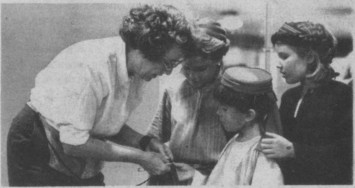
Second Thoughts

You probably have never seen her. She is unlikely to be among those taking curtain calls. But they would not happen or be so enthusiastic if she and her co-workers had not put in long hours of plain hard work. Yet she too has to know the opera to the nth degree and as thoroughly as do the conductor, stage director, lighting supervisor, music director and even Thomson Smillie. Above all, she has to know people.
Who is she? Meet Nancy Hanaford. She is in charge of costuming -- and for the past 20 years, she has been one of our mainstays.
Long before you decided to buy tickets, she began to work on the operas scheduled for the coming season. Unlike the others named earlier, she did not begin by wanting to be director of costuming for an opera company!

It began when a friend, starting to work for an opera company, invited her to become a co-worker.
Nancy's work begins as soon as the schedule is finalized. She peruses the whole opera -- the composer's instructions, words, music, scenery -- in a word, the works. She has to learn as much as possible from past performances.
No opera is ever staged exactly the same way twice. Producing any opera is a living process with living people, none of whom is ever the same. Nancy notes, "If I don't keep up with all that has gone into staging each opera we produce, I wouldn't be here very long!"
"The demands of successfully costuming extends to every person involved in a production even if he or she is on the stage only for a split second. Fitting is a highly personal task including chorus members and prepping supernumeraries. And when we rent costumes from other opera companies, as we do frequently, I have to schedule their arrivals and departures carefully so our preparations are done meticulously and on time. Take our recent production of Aida. It required us to fit 203 persons. If people are not comfortable with what they are wearing, they may not sing or act well. Costuming has to be carefully coordinated with stage settings, lighting and all that is involved in producing a specific opera. Take our recent production of 'The Masked Ball.' Our setting was in New Orleans before the Civil War; so we had to have our people dress accordingly. We have to work closely with everyone who has any part in producing the work."
Nancy never forgets that operatic plots and actions build on the emotions of the characters. The least departure from what is expected can disturb an artist's equilibrium. And how a performer feels about what he or she is wearing and how it fits, can make or break a vital scene. Performing in an opera demands nothing less than total concentration and the least distraction can wreak havoc not only on the artist but on those with whom one sings. Costuming interacts with make-up, lighting, the rapport of performers with each other and the facility with which one can seek to perceive the conductor's instructions, which can come and go like lightning. Even when an opera has a touch which requires a light touch, as in "Cinderella," it is a serious business requiring nothing less than one's very best.
And so, next time you see one of our performances, think of persons like Nancy whose untiring talents and efforts can re-create the marvel of audio and visual presentation which induces you to applaud. And who knows? One day Nancy and her co-workers may get to receive their own curtain calls and she may also receive her own bouquet of flowers.